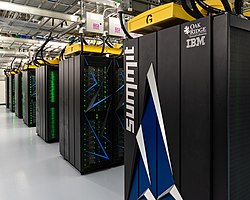Supercomputer

A supercomputer is a computer with great speed and memory. This kind of computer can do jobs faster than any other computer of its generation. They are usually thousands of times faster than ordinary personal computers made at that time. Supercomputers can do arithmetic jobs very fast, so they are used for weather forecasting, code-breaking, genetic analysis and other jobs that need many calculations. When new computers of all classes become more powerful, new ordinary computers are made with powers that only supercomputers had in the past, while new supercomputers continue to outclass them.
Electrical engineers make supercomputers that link many thousands of microprocessors.
Types
Supercomputer types include: shared memory, distributed memory and array. Supercomputers with shared memory are developed by using a parallel computing and pipelining concept. Supercomputers with distributed memory consist of many (about 100~10000) nodes. CRAY series of CRAYRESERCH and VP 2400/40, NEC의 SX-3 of HUCIS are shared memory types. nCube 3, iPSC/860, AP 1000, NCR 3700, Paragon XP/S, CM-5 are distributed memory types.
An array type computer named ILIAC started working in 1972. Later, the CF-11, CM-2, and the Mas Par MP-2 (which is also an array type) were developed. Supercomputers that use a physically separated memory as one shared memory include the T3D, KSR1, and Tera Computer.
Supercomputing centers, organizations
Organizations
- DEISA Distributed European Infrastructure for Supercomputing Applications, a facility integrating eleven European supercomputing centers.
- NAREGI Archived 2008-12-23 at the Wayback Machine Japanese NAtional REsearch Grid Initiative involving several supercomputer centers
- TeraGrid Archived 2007-06-30 at the Wayback Machine, a national facility integrating nine US supercomputing centers
Centers
- BSC Barcelona Supercomputing Center - Spanish national supercomputing facility and R&D center
- CESCA Archived 2008-12-20 at the Wayback Machine Supercomputing Centre of Catalonia - Centre de Supercomputacio de Catalunya
- CESGA Galicia Supercomputing Center - Centro de Supercomputación de Galicia
- CeSViMa Supercomputing and Visualization Center of Madrid
- CINECA CINECA Interuniversity Consortium, Italy
- CINES Centre Informatique National de l'Enseignement Superieur, France
- CSAR UK national supercomputer service operated by Manchester Computing
- EPCC Edinburgh Parallel Computing Centre. Based in the University of Edinburgh.
- GSIC Global Scientific Information and Computing Center at the Tokyo Institute of Technology
- HECToR UK national supercomputer service provided by a consortium of EPCC, Cray and Numerical Algorithms Group (NAG)
- HPCx Archived 2020-01-03 at the Wayback Machine UK national supercomputer service operated by EPCC and Daresbury Lab
- IRB Archived 2008-12-13 at the Wayback Machine
- Minnesota Supercomputer Institute (Formerly Minnesota Supercomputer Center) operated by University of Minnesota
- NASA Advanced Supercomputing facility Archived 2017-12-02 at the Wayback Machine
- National Center for Atmospheric Research (NCAR)
- National Center for Supercomputing Applications (NCSA)
- National Energy Research Scientific Computing Center (NERSC)
- Ohio Supercomputer Center (OSC)
- Pittsburgh Supercomputing Center operated by University of Pittsburgh and Carnegie Mellon University.
- San Diego Supercomputer Center (SDSC)
- SARA Archived 2006-02-08 at the Wayback Machine (Stichting Academisch Rekencentrum Amsterdam), Amsterdam, The Netherlands
- System X Archived 2004-09-17 at the Wayback Machine at Virginia Tech
- Texas Advanced Computing Center (TACC)
- DCSC Danish Centre for Scientific Computing. Based at the University of Copenhagen.
- PSNC (Poznan Supercomputing and Networking Center), Poznan, Poland
- NSC National Supercomputer Centre in Sweden at Linköping University, Sweden
Specific machines, general-purpose
- Linux NetworX press release: Linux NetworX to build "largest" Linux supercomputer
- ASCI White press release Archived 2006-10-08 at the Wayback Machine
- MCR @ LLNL Linux NetworX Supermicro based Supercomputer "3rd largest supercomputer in 2004" Archived 2012-10-10 at the Wayback Machine
- Article about Japanese "Earth Simulator" computer Archived 2008-12-23 at the Wayback Machine
- "Earth Simulator" website (in English) Archived 2007-04-10 at the Wayback Machine
- NEC high-performance computing information Archived 2003-02-07 at the Wayback Machine
- Superconducting Supercomputer Archived 2009-04-18 at the Wayback Machine
- Blue Waters Petascale Computing System Archived 2008-12-11 at the Wayback Machine
Specific machines, special-purpose
- Papers on the GRAPE special-purpose computer Archived 2008-02-22 at the Wayback Machine
- More special-purpose supercomputer information Archived 2003-06-04 at the Wayback Machine
- Information about the APEmille special-purpose computer
- Information about the apeNEXT special-purpose computer
- Information about the QCDOC project, machines
Supercomputer Media
The Blue Gene/P supercomputer "Intrepid" at Argonne National Laboratory (pictured 2007) runs 164,000 processor cores using normal data center air conditioning, grouped in 40 racks/cabinets connected by a high-speed 3D torus network.
A circuit board from the IBM 7030
A Cray-1 preserved at the Deutsches Museum
The CPU share of TOP500
Diagram of a three-dimensional torus interconnect used by systems such as Blue Gene, Cray XT3, etc.
The Summit supercomputer was as of November 2018 the fastest supercomputer in the world. With a measured power efficiency of 14.668 GFlops/watt it is also the third most energy efficient in the world.
Wide-angle view of the ALMA correlator
Archived 2008-12-22 at the Wayback Machine









